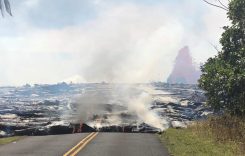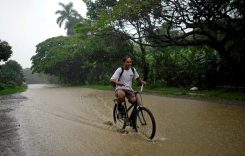A particularly dry season has almost emptied the water tanks of the city of Sao Paulo in Brazil, raising convern to its millions of inhabitants. This crisis comes as two new supply systems have just been inaugurated. Will these infrastructures be sufficient?
Such a water crisis is surprising in a country that has 13% of the world’s freshwater reserves. But the problem is decades old: less rainfall, combined with a growing population and poor public water management policies.
In 2014, the gigantic Cantareira system, built in the late 1970s, supplying water to 45% of the 20 million inhabitants of Sao Paulo and its suburbs, has fallen to a historic minimum. Same thing for the tanks of the two other basins, like that of Guarapiranga.
The lack of rainfall, accompanied by high temperatures in summer and winter that accelerate the evaporation of dams, explains this first crisis. Precipitation during the rainy season from October to March was insufficient. In November, it fell 90 mm, compared to a normal average of 161.2 mm.
The population panicked. The richest have had wells dug. The majority of households must now think about their water consumption and use the water for the first time sparingly.
The authorities, including SABESP, the world’s sixth-largest water company, which serves 26 million people in the greater Sao Paulo area, were not managing the crisis.
The president of the company was dismissed and replaced by a hydrological engineer, Jerson Kelman, who took the helm at the worst of the crisis; there was barely a month of water in reserve. SABESP called the end of the reserves a “plan for the end of the world”.
In order not to be rehearsed, SABESP accelerated its expansion plans, but they were not quite ready in March 2018. Fortunately, the rain calmed the game.
Water Collection A Growing Problem
Yet, in the past, the greater Sao Paulo area had no problem with access to water.
But today, the drizzle has disappeared and it is estimated that 5,000 natural springs have been drained.
The great Tietê River, emblem of the city of Sao Paulo that it crosses, is an open sewer that will be impossible to clean up before 10 or 20 years, if we put the means.
So water, we must look elsewhere, more and more far.
These are titanic works: the Sao Lourenço treatment plant fetches water 50 km southeast of Sao Paulo, makes it climb a 330-meter slope thanks to powerful pumps and adds 6.5 meters cubes per second to the big city’s reserves.
Another system connects the Rio de Janeiro reservoirs with those of Sao Paulo. A pipeline of 20 kilometers, with six tunnels.
Thus, thanks to a reversible pump system, water can be passed from Rio de Janeiro to Sao Paulo, or vice versa, when the need arises. Up to five cubic meters per second are then added to the reserves. Both facilities were inaugurated in April 2018.
With all this, the SABESP thinks to be quiet for the next 20 years.
Unless nature is unleashed. Moreover, it becomes more and more unpredictable. In March 2016, torrential rains killed at least 19 people in the Sao Paulo area. Such droughts and storms were not seen in the past.
SOS forests
Massive urbanization and extensive agriculture have virtually eliminated the “mata atlantica”, as it is called native forest of the Brazilian coast.
“What we see is that the form of rain has changed in these cities,” says Pedro Roberto Jacobi, professor at the Energy and Environment Institute at the University of Sao Paulo. Because of what? Deforestation around reservoirs and expansion of agriculture in the state of Sao Paulo, mainly that of sugar cane for alcohol.”
The only solution: reforest. Which is done, but still too timidly. The NGO SOS Mata Atlantica has made it its mission.
Others go further to find the causes of climate change in Sao Paulo: deforestation in the Amazon.
“The Amazon is exporting moisture and bringing rain in south-east, central-western and southern Brazil, but also in other parts of Bolivia, Paraguay and Argentina, to thousands of kilometers, says Antonio Donato Nobre of the National Institute of Space Research. The exceptional drought in Brazil’s southeastern region, especially Sao Paulo, may already be the result of the destruction of the Amazon. ”
Scientists also point out that the heavy rains in the Asia-Pacific, the higher temperature of the oceans and the drought in California are interconnected and are part of the same global imbalance.
Beth Letang is a reporter for Cleveland Post Gazette. After graduating from college, Beth got an internship at NPR and worked as a reporter and producer. Beth has also worked as a reporter for ESPN. Beth covers entertainment and community events for Cleveland Post Gazette.





